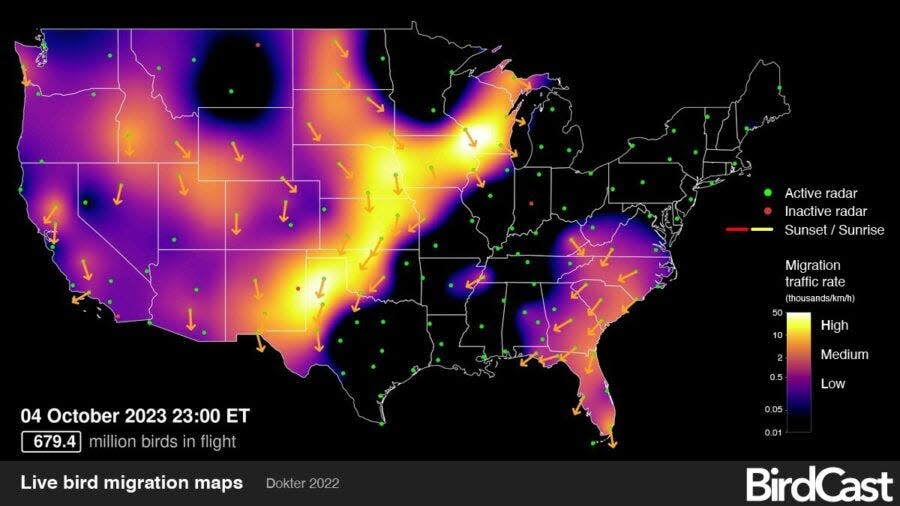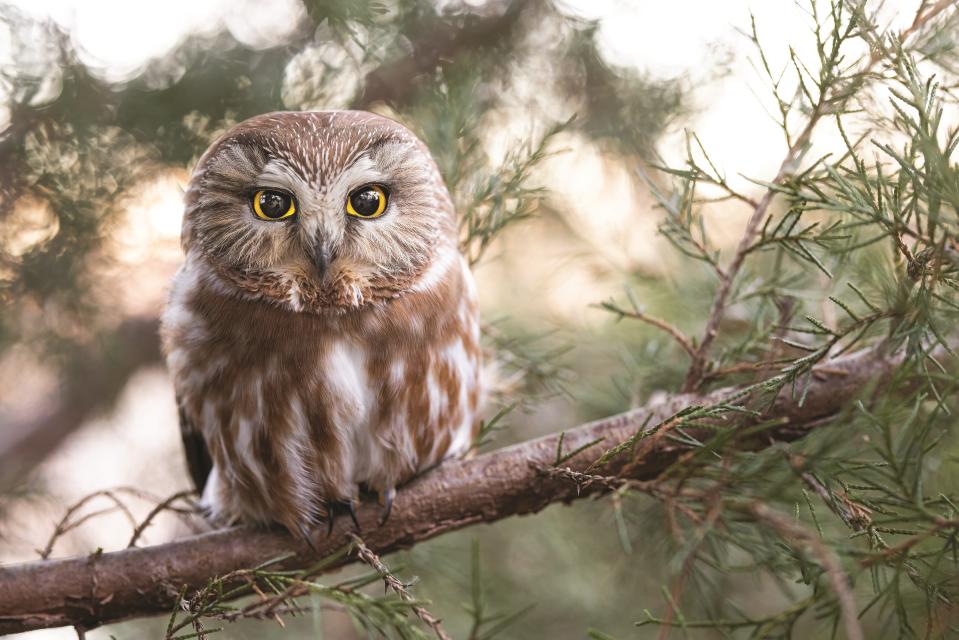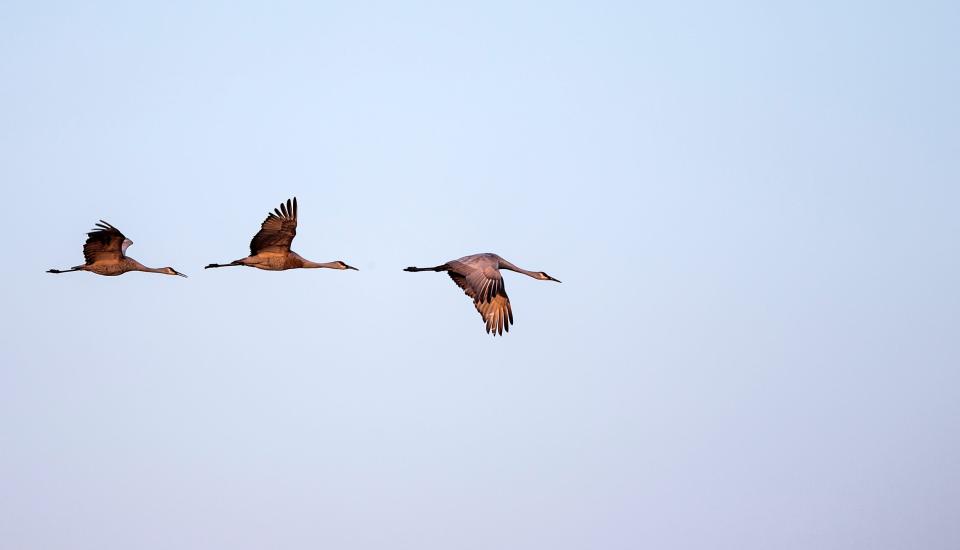As fall bird migration delights with owls and sandhill cranes, tragedy falls on Chicago

The fall migration of birds can be a thrilling time, when the smallest to the largest of species move by the hundreds through our area.
But it took a tragic turn overnight Oct. 4 and 5 in Chicago as nearly 1,000 of them, including warblers and other kinds, died as they crashed into buildings at the McCormick Place convention center along the Lake Michigan shore.
The Field Museum, which gathered and cleaned the birds to preserve for its collections, reports that it was the worst recorded bird casualty in 40 years.
Migratory birds already follow the lakeshore like a highway. Many of them migrate in huge numbers at night, for reasons that still aren’t fully clear. Weather patterns play a key role as they sweep southward. The BirdCast website that’s run by ornithology researchers, https://birdcast.info, uses radar technology to track these massive bird movement across the continental United States. Like the weather, what often passes through Chicago also can come our way.
That night, the weather and conditions apparently channeled the birds at low elevations and toward the buildings. That combined with a wave of particularly intense numbers of birds. On the BirdCast map, you can see the strong wave. Ahead of that, there was almost no sign of migration because of storms.
Aug. 9, 2023: Want a better backyard habitat? IUSB team finds insight through moths at local parks.
Then the birds came upon large buildings. Lights are known to distract and divert birds from their migration pattern. Conservationists urge cities to turn down their lights at night to avoid such tragedies.
Various species died, from northern flickers to belted kingfishers, among others.
The McCormick Place posted a statement at its website saying that it’s “truly saddened,” adding: “The well-being of migratory birds is of high importance to us, and we are truly saddened by this incident. McCormick Place has been actively involved in bird conservation efforts, including maintaining the six-acre McCormick Place Bird Sanctuary along the lakefront; working with the Field Museum and Chicago Bird Collision Monitors; and participating in the Lights Out Chicago Program, which has helped reduce the number of bird collisions on campus by 80%. As the campus is continuously upgraded, McCormick Place has worked with experts to incorporate new technologies to further prevent emanating light from our buildings.”
McCormick Place said lights are turned off unless they’re needed for employees or an event. “As soon as the space is unoccupied,” it noted, “the lights have been turned off.”
Meanwhile, three observers on BirdCast reported 134,000 birds passing in an hour at Promontory Point in Chicago’s Burnham Park. Another observer wrote of “utter madness” counting 120,000 warblers from his porch in northern Chicago.

Owls banded in the dunes
On a brighter note, Indiana Audubon invites the public to come watch as tiny northern saw-whet owls — no bigger than an adult human hand — are safely captured during their fall migration, then banded as part of the 15th annual Project Owlnet research in the Indiana Dunes.
The owl banding will be on Thursday through Sunday nights from Oct. 17 through Nov. 11. Registration is required because space for this popular activity is limited each night. Each demonstration will begin at 7 p.m. CDT (6 p.m. CDT starting Nov. 5) outside at the Indiana Dunes Visitor Center, 1215 N. Indiana 49, Porter. Visitors can stay as late as they like; volunteers check the special owl-catching nets at least three times per night.
The Indiana Dunes is one of the project’s 125 banding stations in the U.S., Canada and Mexico. Indiana Audubon Executive Director Brad Bumgardner, who’s been leading the local project locally, says it offers insight into the health of ecosystems, adding, "These owls are our sentinels of change, and by studying them, we become their stewards, ensuring their place in the forests where they live, breed and overwinter.”

Unlike the Chicago casualties, this one isn’t seen in large numbers. So it’s unpredictable to tell if and when owls will appear each night. Weather can play a role, though. In fact, the owl nights will be canceled if there is heavy wind or rain. Live owl ambassador birds from Humane Indiana Wildlife will be there on certain nights.
Visitors should bring their own lawn chair or blanket, warm clothing, and their snacks and drinks. A campfire with S’mores will be available on most nights.
Cost is $5 for the donation-based research.
Sept. 6, 2023: Beauty vs. beast? What urban river parks need to do to help native plants thrive.
There will be special behind-the-scenes nights on a few select nights where you can join volunteers in the set-up and take-down of the collection nets and have a closer view of the work ($50 for adults, $30 for youths).
Find more details and register through an eventbrite.com website; find a hyperlink here in this column online. Or find the events listed at indianaaudubon.org/events.
Dunes water bird counts
Will Keller is blogging about his visits to the Indiana Dunes beach at Marquette Park in Gary to observe and track water birds during their fall migration. The dunes serve as a kind of funnel for such birds on the move. Lake Michigan channels their journey like a highway. The annual project is coordinated by Indiana Audubon.
Keller reports that September was a quiet month, though on Oct. 1 he wrote of his excitement over seeing a short-eared owl coming across the lake mid-day. September’s warmth may have caused the lull, but, he surmised, perhaps this cool front will flush more water birds into view.
On Sept. 23, he reported another surprise: a couple hundred broad-winged hawks in flocks, or kettles. As he described, the hawks use warm pockets of air to rise, then descend to the next thermal — best done when it’s warm. Keller will continue the blog until Nov. 25 at indianadunesbirding.wordpress.com.

Sandhill crane counts
The annual count of sandhill cranes has begun at Jasper-Pulaski Fish & Wildlife Area in Medaryville, Ind. A total of 744 of the slender, graceful birds were logged on Oct. 4, compared with 2,069 on the same date in 2022. The number typically ramps up until it peaks in late November and early December. Last year, it hit a high of 31,975 on Nov. 22.
The counts are done each Tuesday (or the following day if it’s inclement weather) until late December. They’re posted at a website with a hyperlink here in this column online. But now is still a good time to see the cranes gather by the hundreds at sunrise or sunset, especially at Jasper-Pulaski's observation platform, where you can watch them at their overnight roosting marshes.
So, it’s a good reminder that annual Crane Cruise bike ride returns Oct. 14 out of the fire station in Medaryville, off of U.S. 421. You'll ride routes of 14 to 50 flat miles with rest stops, eat a meal of soups, hot dogs and sausages and then enjoy a guided presentation on the cranes at the Jasper-Pulaski platform at 5 p.m. EDT. Registration will run from 8 a.m. to 2 p.m. Cost is $35 per person, $90 per family. (cranecruise.com, 219-204-1430)
Big Day for birding
Several nature preserves across Indiana will host guided hikes Oct. 14 to identify and count birds. You’ll be with local experts. It’s free, but you need to register through Indiana Audubon. Find a hyperlink here in this column online. Two of the hikes are local.
Evie Kirkwood will lead a hike from 9 to 11 a.m. at Lydick Bog Nature Preserve in South Bend.
Lindsay Grossman will lead a hike from 9 to 11 a.m. CDT at Ambler Flatwoods Nature Preserve (trails can be muddy) in Michigan City. To find Ambler Flatwoods, go east toward Michigan City on U.S. 20, cross Interstate 94 and take the first right turn onto Meer Road/North County Road 600 West. Go two miles and find the parking lot on the left.
Work and play
∎ Weed Wrangle: Help to remove invasive plants from 10 a.m. to 2 p.m. Oct. 14 at Potato Creek State Park in North Liberty with the park’s friends group. A lunch of hot dogs and chips will be provided. Meet at the nature center.
∎ Spokes and Spirits: Lincoln Ave. Cycling, at 430 W. Lincoln Ave., Goshen, will host this leisurely, family-friendly ride between and through the “eerie yet enchanting paths” of Oakridge, West Goshen and Violett cemeteries on Oct. 19, departing at 5:30 p.m. Costumes on you and your bike are encouraged. Lights and helmets are required.
Find columnist Joseph Dits on Facebook at SBTOutdoorAdventures or 574-235-6158 or jdits@sbtinfo.com.
This article originally appeared on South Bend Tribune: Owls sandhill cranes migrate fall but Chicago birds hit buildings

